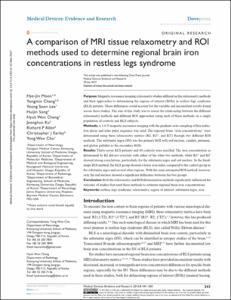A comparison of MRI tissue relaxometry and ROI methods used to determine regional brain iron concentrations in restless legs syndrome
- Keimyung Author(s)
- Moon, Hye Jin; Cho, Yong Won; Chang, Hyuk Won; Ku, Jeong Hun
- Department
- Dept. of Neurology (신경과학)
Dept. of Radiology (영상의학)
Dept. of Biomedical Engineering (의용공학과)
- Journal Title
- Medical Devices
- Issued Date
- 2015
- Volume
- 8
- Abstract
- Purpose: Magnetic resonance imaging relaxometry studies differed on the relaxometry methods and their approaches to determining the regions of interest (ROIs) in restless legs syndrome (RLS) patients. These differences could account for the variable and inconsistent results found across these studies. The aim of this study was to assess the relationship between the different relaxometry methods and different ROI approaches using each of these methods on a single population of controls and RLS subjects.
Methods: A 3.0-T magnetic resonance imaging with the gradient-echo sampling of free induction decay and echo pulse sequence was used. The regional brain “iron concentrations” were determined using three relaxometry metrics (R2, R2*, and R2′) through two different ROI methods. The substantia nigra (SN) was the primary ROI with red nucleus, caudate, putamen, and globus pallidus as the secondary ROIs.
Results: Thirty-seven RLS patients and 40 controls were enrolled. The iron concentration as determined by R2 did not correlate with either of the other two methods, while R2* and R2′ showed strong correlations, particularly for the substantia nigra and red nucleus. In the fixed-shape ROI method, the RLS group showed a lower iron index compared to the control group in the substantia nigra and several other regions. With the semi-automated ROI method, however, only the red nucleus showed a significant difference between the two groups.
Conclusion: Both the relaxometry and ROI determination methods significantly influenced the outcome of studies that used these methods to estimate regional brain iron concentrations.
- Publisher
- School of Medicine
- Citation
- Hye-Jin Moon et al. (2015). A comparison of MRI tissue relaxometry and ROI methods used to determine regional brain iron concentrations in restless legs syndrome. Medical Devices, 8, 341–350. doi: 10.2147/MDER.S83629
- Type
- Article
- ISSN
- 1179-1470
- 파일 목록
-
-
Download
 oak-2015-0006.pdf
기타 데이터 / 872.28 kB / Adobe PDF
oak-2015-0006.pdf
기타 데이터 / 872.28 kB / Adobe PDF
-
Items in Repository are protected by copyright, with all rights reserved, unless otherwise indicated.